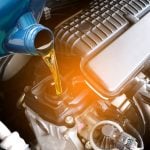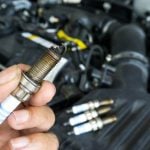Are you all set for your long-awaited vacation, but your car just won’t start? Or maybe you face this issue every day, making starting your car’s engine a dreadful chore. Whatever the case may be, don’t worry! Way.com has got you covered with a quick and detailed guide to help you understand your options to get your car started.
The component of your car that starts the engine is the starter. Essentially, the engine is started by a little electric motor. The starter assists in providing the car with the power it needs to drive from a stop by starting the engine.

Battery or Starter? Is the Battery of Your Car the Source of the Problem?
Your vehicle won’t start most of the time because of a poor battery. A poor battery frequently manifests itself in certain ways. If it is because of a poor battery, you will hear the starter produce a droning sound as it starts to turn and then slows down. Rapidly succeeding solenoid engagements and disengagements are possible. If this occurs, you will hear a sharp clicking sound. When the battery is totally dead, all you may hear is a single click.
You can use the horn or the windshield wipers to test whether the battery is healthy. The battery isn’t supplying the power necessary to start your automobile if the wipers or horns make a dull noise.
You’ll need jumpers to start your car if your battery is the issue. The starter or the electrical connections to the starter should be considered the primary culprits in your starting issues if the battery is in good condition.
Can You Jump-Start a Car with a Bad Starter?
Most of the time, NO, you can’t jumpstart a car with a bad starter unless you repair it.
When the battery is dead, jumper wires or boosters are employed. You use a second battery to provide the necessary electricity to start the car. However, attaching a jumper directly to the starter may work as a fix if the issue is brought on by a faulty connection to the starter. Some individuals could mistake a bump start (or push start) for a jump start.
A car with a manual transmission can be started using this technique.
- The dashboard warning lights will turn on when you turn the ignition key to the on position.
- Put the automobile in second or third gear if possible.
- As another person pushes the car to get it moving, keep the clutch compressed. Release the clutch once the automobile has started moving. The automobile will likely tremble a little before the engine starts. Before the car starts, it can take a few attempts.
- If you initially fail, give the automobile a bit more forward motion before releasing the clutch.
You might not be able to jump-start your car with a bad starter, but you may be able to refinance your ride! Way Auto Refinance makes it easy with pre-qualified rates that you can access in less than a minute. The best part? Checking your rates won’t have any impact on your credit score. Start managing your auto loan the smart and easy way today!
Symptoms of a Bad Starter
- Grinding noise.
- Freewheeling.
- The car starts intermittently.
- Hear a clicking sound.
- The starter doesn’t turn off.
- Smoke.
- Lights dim when starting the car.
- Starter spinning.
- Oil soak and leak.
- Damaged solenoid.
Common Reasons for Car Starter Problems
Car starter issues are frequently caused by loose terminals, corroded terminals, broken or worn-out system components, and more. Generally, you can expect a starter to last for a long time. A starter replacement on a low-mileage vehicle is unusual.
How To Start A Manual Car With A Bad Starter
A car’s engine won’t start if you jump-start it with a damaged starter motor. Jump-starting just increases the power of the battery. An auto transmission automobile cannot be pushed or towed started. However, a manual transmission car with a broken starter may.
Things You Can Do to Try to Start the Car:
Check Connections
Check to see whether the starter battery pathway has any loose connections.
Make sure the starter motor’s current connections to the battery are safe and corrosion-free. The battery powers the starter motor. Therefore everything must be in functioning order.
Look for Corrosion
Under the hood of an automobile is where corrosion frequently causes problems and failures. Corrosion can damage cables because it interferes with connections and the engine’s ability to conduct electricity. Corrosion can be eliminated by washing the terminals in hot water after cleaning them with water and sodium bicarbonate in equal parts.
- Start by removing the battery.
- Prepare a mixture of half sodium bicarbonate and half water.
- Pour the mixture over the battery.
- Let it soak for a few minutes.
- Rinse with hot water.
Bypass the Relay
A bad starter relay may be to blame if you try to turn on the ignition switch, but the car won’t start.
A screwdriver with an insulated grip should be in your hand.
By touching the tip of the screwdriver to the solenoid’s battery terminal and the “S” terminal of the solenoid, you can bypass the malfunctioning relay.
Request someone’s assistance to turn on the ignition switch.
Tap the Starter
The armature and field coils of the motor frequently acquire dead patches over time.
These dead spots can be removed, and the starter’s motor can run by gently tapping the malfunctioning starter with a hammer.
Check battery voltage
To check whether the starter solenoid is getting enough power from the battery or whether the battery is dead, use a voltmeter or multimeter.
Check the solenoid cable
The solenoid cable is in charge of coupling the starter to the transmission’s ring gear. The solenoid cable probably needs to be repaired if you hear a cranking noise. Check the cable for signs of wear and tear.
Check the Fuel Gauge
Have you checked if your gas tank is empty? This may seem like a little silly, but it could be the reason why your car isn’t starting. Give it a quick look and see if it needs to be refilled.
If your car won’t start, sometimes tapping the starter can temporarily fix the problem. However, it’s important to have a qualified technician check the issue to prevent further problems. If tapping or jumpstarting doesn’t work, you’ll likely need to get your car towed and have the starter repaired or replaced.
Other Ways to Start a Car
- Jump Start the Car
- Push start the car (This only applies to manual vehicles.)
Equipment required to Jumpstart / Push start your car
- Jumper cables
- A hammer
- Gloves
- A screwdriver
Jump Starting a Car
The same method is applied when your automobile battery cannot maintain a sufficient charge to start your vehicle.
To do this, you’ll need a different vehicle.
- Find the car battery by opening the hood of your vehicle. If your car battery looks bloated or leaks, you may have to replace the battery.
- If the car battery appears to be in good condition, connect the positive terminal of your weak battery to the positive terminal of the spare battery using the positive wire (red jumper cable) or a jump starter.
- Utilizing the black jumper cable, attach the negative terminal of the charged battery to any exposed metal on the car.
- Your automobile should be able to start as a result, even with a damaged ignition system.
- Now, turn on the ignition and wait a few minutes to let the battery charge.
For more details, read How to jump-start your car in 5 easy steps – Way
Push Starting a Car
Only try this if your vehicle has a manual transmission because it will damage an automatic vehicle.
- The key should be turned into the driving position.
- Depress the clutch all the way and shift into first or second gear.
- While you’re driving, ask someone else to push the vehicle. Generally speaking, a small downward slope makes it easier to start.
- Release the clutch when the vehicle achieves a speed of 5 to 10 mph.
- This should start the car. If not, try it again.
All of these methods are temporary fixes. It is better to get the vehicle checked at a workshop or dealership as soon as possible.
Although having trouble starting a car is a fairly typical problem, replacing a broken starter on your own can be challenging. Starting problems can occasionally be caused by other things like faulty spark plugs or even a fuel pump.
Therefore, the easiest solution is to have a professional evaluate your auto starter issues.
How do you temporarily start a car with a bad starter?
Put the car in second gear and have two or three strong friends help push it. Build up some speed and then release the clutch while turning the key. If done correctly, the car should start.
Will a car stay running with a bad starter?
It’s not very likely that a faulty starter motor would cause a running engine to stop, but it can happen. There are a few things that need to take place first. If the starter motor is bad or shorted, it can drain the battery of the car.
How long can you drive with a bad starter?
It’s not recommended to keep driving if your starter isn’t working properly. For instance, even if you’re able to drive for a short distance, it can be dangerous and could cause your engine to fail. It’s better to address the issue sooner rather than later to avoid any potential hazards.
Why does tapping a starter make it work?
The starter works by using brushes to make contact with the armature’s commutator bars. However, if the brushes are worn out, they may have trouble making contact. Consequently, it can cause problems. This issue is most noticeable when the starter is being used. It’s important to be careful not to hit the starter too hard, as this can damage the permanent magnets in the motor.

Sara Sam may not look like your typical car and finance expert, but don’t let that fool you. With over four years of experience in the industry, she knows all the ins and outs of cars, car insurance, and refinancing. You can trust Sara to help you navigate the often-confusing world of automobiles and financing.



















